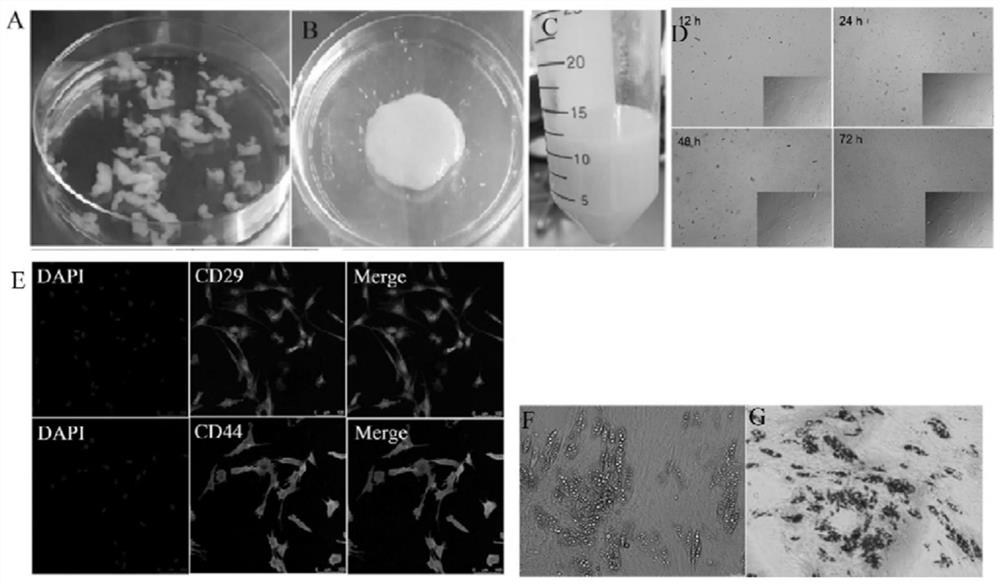Method for preparing plant-based fat cultured meat
A plant and medium technology, applied in the field of stem cells and animal cell cultured meat, can solve the problems of inedible cross-linking agents, poor culture effect, and contrary to the original intention, and achieve the effect of improving sensory quality and nutritional characteristics
- Summary
- Abstract
- Description
- Claims
- Application Information
AI Technical Summary
Problems solved by technology
Method used
Image
Examples
Embodiment 1
[0071] Example 1 Isolation of porcine adipose-derived mesenchymal stem cells:
[0072] (1) Single cell isolation: Take freshly slaughtered piglets and soak them in 75% (volume percent) ethanol for one minute, then take the subcutaneous adipose tissue of the neck under aseptic conditions and store it in the basal culture medium. Under sterile conditions, rinse 3 times with PBS buffer containing high concentration of penicillin and streptomycin, cut off the visible blood vessels and connective tissue in the adipose tissue, and cut the adipose tissue into 1mm 3 The left and right small pieces were digested with 0.1% (mass percentage) type I collagenase and 3% (volume percentage) penicillin-streptomycin double-antibody digestion solution for 90 min (37°C, shaking in a water bath) ( figure 1 A-C).
[0073] (2) After digestion, neutralize the digestion solution with an equal volume of complete culture solution, filter with 100 μm and 40 μm cell sieves, and centrifuge at 1500 rpm fo...
Embodiment 2
[0076] Example 2 Preparation and optimal sterilization method of peanut drawing protein scaffold
[0077] (1) Preparation of peanut drawing protein scaffold: the commercially available peanut drawing protein (Qingdao Changshou Food Co., Ltd., filament type) was soaked in distilled water for 5 minutes, and it was completely swelled by water absorption. The results showed that the commercially available peanut protein The stent is light yellow after fully absorbing water, with a loose and porous structure, soft in wet state, and has a certain elasticity ( figure 2 A). Cut the peanut drawing protein scaffold into cubes with a size of 0.6cm × 0.6cm × 0.1cm ( figure 2 B), sterilize the peanut drawing protein scaffold with different sterilization methods:
[0078] Group 1: Add 15 mL of 75% alcohol for immersion and sterilization for 1.5 hours, discard the alcohol, wash three times with 15 mL of PBS, and soak in 15 mL of growth medium overnight;
[0079] Group 2: The cut scaffol...
Embodiment 3
[0086] Example 3 Three-dimensional plant-based cell scaffold material suitable for fat cultured meat and material pretreatment
[0087] (1) Adhesion of adipose stem cells on three kinds of plant-based protein scaffolds: In Example 2, it has been verified that peanut silk protein scaffolds can provide cell adhesion sites for adipose stem cells. This example further explores whether wheat silk protein and soybean silk protein are Also suitable for use as a cell scaffold for fat cultured meat. The specific operation is as follows: according to the steps of Example 2 (3), the adipose stem cells obtained in Example 1 are labeled with a live cell tracer and then inserted into a wheat drawing protein scaffold (Qingdao Changshou Food Co., Ltd., filament type) and soybean drawing On the protein scaffold (Qingdao Changshou Food Co., Ltd., filament type), the adhesion of cells on the wheat protein scaffold and soybean protein scaffold was observed with an inverted phase contrast fluoresc...
PUM
 Login to View More
Login to View More Abstract
Description
Claims
Application Information
 Login to View More
Login to View More - R&D
- Intellectual Property
- Life Sciences
- Materials
- Tech Scout
- Unparalleled Data Quality
- Higher Quality Content
- 60% Fewer Hallucinations
Browse by: Latest US Patents, China's latest patents, Technical Efficacy Thesaurus, Application Domain, Technology Topic, Popular Technical Reports.
© 2025 PatSnap. All rights reserved.Legal|Privacy policy|Modern Slavery Act Transparency Statement|Sitemap|About US| Contact US: help@patsnap.com



